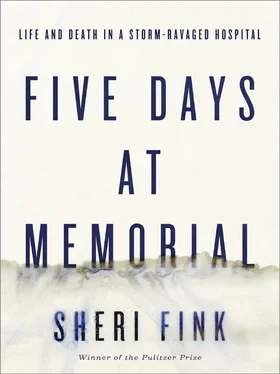That drive to be the one on the team always doing her best, however, made her into a strong patient advocate. She was soon promoted to director of the Division of Head and Neck Surgery in her department. She made great friendships in Galveston, but her work came first. Almost two years after she moved into her house, Pou invited colleagues for a visit. She switched on the oven. The house filled with smoke. The packing materials were still inside.
Another time, when a surgeon’s wife asked Pou to help out with Junior League, Pou accepted, despite her packed schedule. The surgeon’s wife asked her to print off labels for a large event mailing. “My grandmother would roll over in her grave,” Pou said. Invitations were hand lettered in New Orleans. The surgeon’s wife reminded her she was in Texas now. It didn’t matter. Pou used her spare free time at night to address the envelopes one by one.
Pou was a lady. She might spend her days in surgical scrubs, but she made it a point to find a favorite Texas hairdresser. Raoul coaxed her straight cinnamon locks into a proper hairdo. On the occasions she had to dress up, Pou tempered New Orleans exuberance with a classic uptown finish, pairing pearls with plunging necklines that flattered her figure.
During those years in Texas, Pou’s father died, leaving her mother a widow in New Orleans. The beloved chairman of Pou’s department stepped down. He had been an innovator in the field and had mentored Pou and taken great interest in her career. A new chairman was promoted from within the department. He was four years younger than Pou and had a PhD in addition to his medical degree. The two weren’t close. The program seemed headed in a different direction, with more emphasis on research. Pou’s passion was for taking care of patients. She decided to leave, weighing offers from as far away as San Diego.
Over the years, at various national meetings of her specialty, Pou had developed a friendly relationship with the head of otolaryngology at Louisiana State University, Dr. Daniel W. Nuss, whose private practice was located at Memorial Medical Center. Nuss, too, treated head and neck cancers and had built a program focused on tumors and reconstruction—Pou’s type of work. His program also served patients at the Medical Center of Louisiana at New Orleans, better known as Charity Hospital, including prisoners and many people who lacked health insurance. They had both trained in Pittsburgh and grown up in New Orleans; one of Nuss’s brothers had briefly dated one of Pou’s sisters. Nuss had asked Pou several times if she would ever consider moving back to New Orleans. Now Pou was ready to say yes.
“Dr. Pou, we regard this as an exciting opportunity, and it is indeed with pleasure that we invite you to join our faculty,” Nuss and the dean of LSU’s medical school wrote in her official employment offer. Pou inked her acceptance in April 2004.
While the state university employed Pou and provided her with liability insurance, Memorial Medical Center made an important contribution to her move, advancing the university more than $350,000 to pay her first year’s salary and expenses against her future earnings as a surgeon. In exchange, Pou would join Memorial’s medical staff and also see patients in its emergency room when she was on call, without additional pay. It was a no-lose situation for profit-conscious Tenet Healthcare, Memorial’s owner. The university had to pay back the guarantee payments, and with university physicians on staff, Memorial qualified as a teaching hospital and was eligible for additional funds from Medicare.
On September 1, 2004, Pou took up her position as an associate professor at LSU in New Orleans. She began seeing patients in October. The move was meant to be a permanent one. In November, Panepinto purchased a $349,000 house near the hospital, taking out a loan for 80 percent of its price. In early 2005, the couple sold their home in Galveston.
Pou was given a tour of Memorial and introduced to the operating-room nurses. “Dr. Poo?” one asked. “No, Pou,” she said, pronouncing it her family’s way, “Poe,” as if it rhymed with “toe.” “Sorry,” the nurse said. She sized up Pou, a tiny lady rolling a tiny piece of Samsonite luggage behind her. This was the much-heralded new surgeon? “You gotta see this!” the nurse whispered to a colleague. Judging her on looks alone, the nurses didn’t believe that the diminutive Pou was capable of performing tedious, draining, backbreaking all-day operations. She didn’t appear to have that kind of stamina.
Pou would have to prove herself. She did not win over everybody she met.
DR. HORACE BALTZ WAS, at seventy-one when Katrina approached, one of the hospital’s longest-serving doctors and a former president of its medical staff. He had treated patients at Memorial and Baptist for more than four decades and still performed basic blood tests by hand rather than sending them to a lab like just about every other doctor did. In his office, he kept a large black-and-white photo of a nurse in a white cap holding a cup of water to the lips of an elderly man lying on a cot. He and the nurse had worked together in 1965 caring for displaced residents after Hurricane Betsy.
Baltz was the son of a motion-picture projectionist, the youngest of five children, and the first in his family to attend college. He could remember, from his days as a high school delivery boy for the neighborhood drugstore, filling prescriptions for Dr. Frederick Pou, Anna’s father.
Proud, boisterous, and principled, Baltz liked to reminisce about the days when the community’s “medical giants” strode the halls of Southern Baptist Hospital. In the course of his career, he had witnessed two significant changes in the practice of medicine. One was the advent of high-technology life support for patients with critical illnesses. Southern Baptist was believed to have been the first hospital in the Southeast to purchase a “crash cart”—a piece of equipment wheeled in during a Code Blue to resuscitate patients who had stopped breathing or whose hearts had stopped beating. The cart contained drugs, a respirator to fill the lungs with oxygen, an aspirator to clear the airway, a cardiac monitor to keep tabs on the heart’s electrical rhythm, a pacemaker to stimulate the heartbeat, and a defibrillator to shock a dying heart back into a functional rhythm. It was a momentous purchase, trumpeted by an article in the local newspaper in 1967. At the same time, Baptist expanded its physical plant and added piped-in oxygen and an intensive care unit for heart patients, complete with alarm systems to alert staff to irregular heartbeats and other emergencies. “In the event of a failure in City electrical power, each unit will be on our auxiliary power, so that no interruption can ensue,” Baptist’s administrator wrote in a June 1967 newsletter.
Intensive care grew to become a major specialty at Memorial and across the country. With it came new ethical challenges and a changing definition of what constituted “extraordinary measures” in medicine. When should life support be instituted? Critical care, transplant surgery, and other new practices were expensive. On the heels of their invention came the second big change: cost consciousness and the rise of for-profit medicine. By the early 1980s, health care was a medical marketplace. “Many of us have trouble accepting the business motive in medicine rather than the professional ethic,” Baltz told a Baptist Hospital newsletter writer in the mid-1980s. Baptist was still nonprofit and faith-based, but it had to compete in an increasingly commercialized environment. Its doctors, and many across the country, feared being told by accountants and other nonclinicians what tests and treatments they could give to which patients.
Читать дальше













